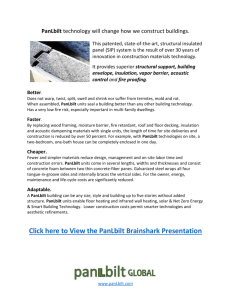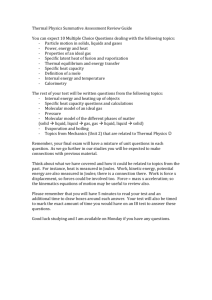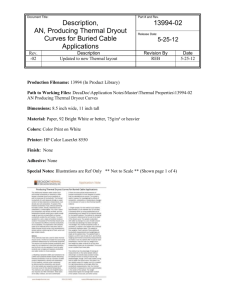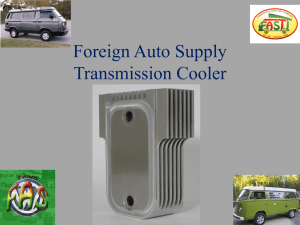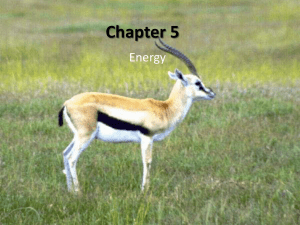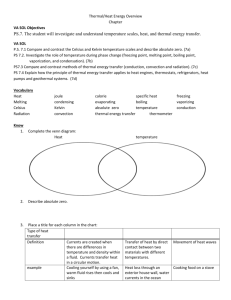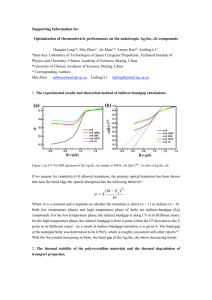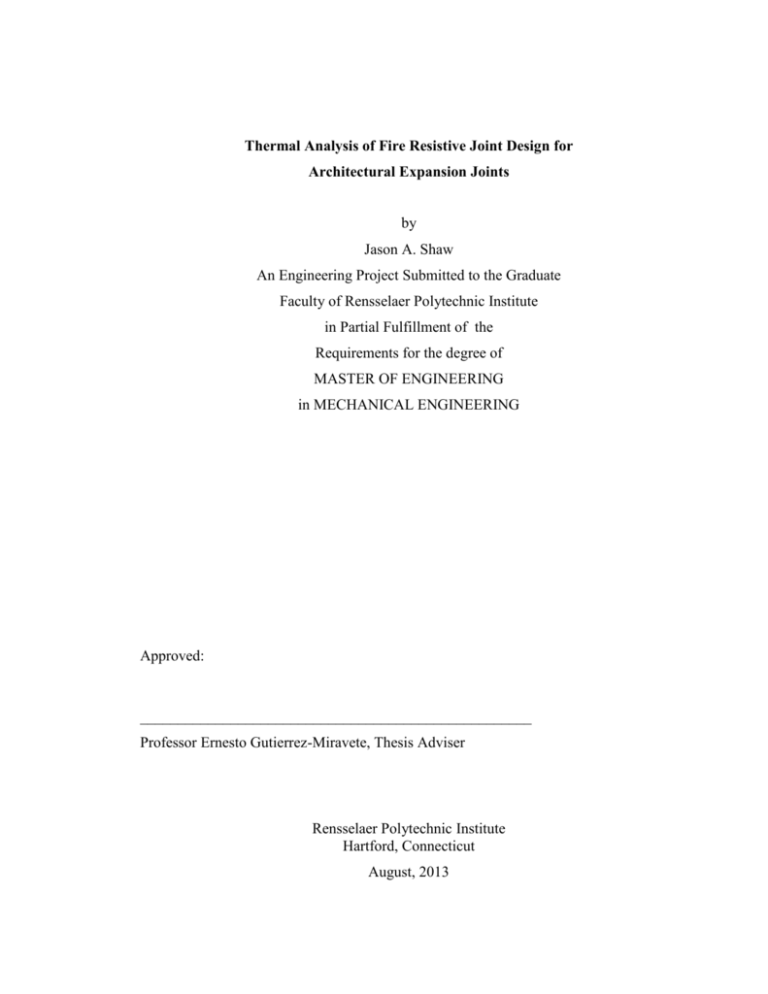
Thermal Analysis of Fire Resistive Joint Design for
Architectural Expansion Joints
by
Jason A. Shaw
An Engineering Project Submitted to the Graduate
Faculty of Rensselaer Polytechnic Institute
in Partial Fulfillment of the
Requirements for the degree of
MASTER OF ENGINEERING
in MECHANICAL ENGINEERING
Approved:
____________________________________________________
Professor Ernesto Gutierrez-Miravete, Thesis Adviser
Rensselaer Polytechnic Institute
Hartford, Connecticut
August, 2013
© Copyright 2013
by
Jason A. Shaw
All Rights Reserved
ii
Table of Contents
List of Tables .................................................................................................................... iv
List of Figures .................................................................................................................... v
Nomenclature .................................................................................................................... vi
Acknowledgement ........................................................................................................... vii
Abstract ........................................................................................................................... viii
1. Introduction.................................................................................................................. 1
1.1
Background ........................................................................................................ 1
1.2
Project Scope...................................................................................................... 2
2. Literature Review ........................................................................................................ 4
3. Methodology and Approach ........................................................................................ 6
3.1
COMSOL Physics .............................................................................................. 8
3.2
Boundary Conditions ......................................................................................... 8
4. Results........................................................................................................................ 13
5. Conclusions................................................................................................................ 20
6. References.................................................................................................................. 21
iii
List of Tables
Table 1: Material Properties .............................................................................................. 7
iv
List of Figures
Figure 1: Example of an Architectural Expansion Joint .................................................... 1
Figure 2: Illustration of Fire Barrier Design (Note: Cover Plate Not Shown) .................. 3
Figure 3: COMSOL Model Geometry............................................................................... 6
Figure 4: Physics Controlled COMSOL Mesh .................................................................. 7
Figure 5: Thermal Insulation and Prescribed Displacement Boundary Condition ............ 9
Figure 6: Free Boundary Condition ................................................................................... 9
Figure 7: Temperature Boundary Condition.................................................................... 10
Figure 8: ASTM E119 Fire Temperature vs. Time ......................................................... 11
Figure 9: Convective Cooling Boundary Condition ........................................................ 12
Figure 10: Surface Temperature Plot at Time = 1 hr ....................................................... 13
Figure 11: Surface Temperature Height Extension Plot .................................................. 14
Figure 12: Surface Plot of Total Heat Flux Magnitude ................................................... 15
Figure 13: Unexposed Side Surface Temperature as a Function of Time ....................... 16
Figure 14: Temperature Profile Through Concrete Slab ................................................. 17
Figure 15: Unexposed Side Surface Temperature as a Function of Arc Length ............. 18
Figure 16: First Principal Stresses ................................................................................... 19
v
Nomenclature
a
A
b
CP
Fo
h
I
Ib
k
L
P
q
r
s
S
t
T
V
α
β
Δt
Δx
λ
ε
ρ
κ
Ω
Θ
Φ
σ
-
Scattering slop of phase function
cross sectional area of slab
Backscatter factor
Specific Heat
Fourier number
Combined heat transfer coefficient
Intensity
Black body intensity
Thermal conductivity
Slab thickness
Phase function
Heat flux
Physical dimension
Scattered
Radiative source function
Time
Temperature
Control volume
Thermal diffusivity
Mass extinction coefficient
Time-step
Control volume length increments
Wavelength
Emissivity
Density or Reflectance
Absorption coefficient
Scattering direction
Normal scattering angle
Azimuthal scattering angle
Surface roughness or scattering coefficient or Stefan-Boltzmann constant
vi
Acknowledgement
Type the text of your acknowledgment here.
vii
Abstract
Type the text of your abstract here.
viii
1. Introduction
1.1 Background
Architectural expansion joints are openings or gaps that are designed into the
structure of a building to permit movement between the concrete slabs or other structural
members. Building movement can occur for several reasons, including thermal loading
(i.e., change of weather season), wind loading, or seismic activity. These openings can
vary anywhere between 0.5 inches up to and exceeding 32 inches. Typically, a metal
cover plate is installed over the expansion joint to conceal the joint and to permit
pedestrian traffic across the joint. An example of an architectural expansion joint can be
seen in Figure 1.
Figure 1: Example of an Architectural Expansion Joint
1
Building codes often require that these expansion joints include a fire resistive
system, or fire barrier, to prevent the spread of smoke, heat, and flames in the event of a
fire.
Underwriters Laboratories (UL) 2079, "Standard for Tests for Resistance of
Building Joint Systems" [1], is the standard test method used in industry today to qualify
cover plate and fire barrier designs.
There are several acceptance criteria for the
standard, which are as follows:
1. When exposed to a fire, the transmission of heat through the fire barrier and
cover plate assembly must not raise the unexposed side surface temperature more
than 250 ⁰F (~139 K). The fire barrier is then rated as having satisfied this
criteria for a stated period of time (0.5 hours, 1 hour, or 2 hours). UL 2079 takes
this criteria from American Society for Testing and Materials (ASTM) Standard
E1966, "Standard Test Method for Fire-Resistive Joint Systems" [2].
2. The fire barriers and cover plate assembly must withstand a cyclic movement
test. UL 2079 takes this criteria from ASTM Standard E1399, "Standard Test
Method for Cyclic Movement and Measuring the Minimum and Maximum Joint
Widths of Architectural Joint Systems" [3].
1.2 Project Scope
The goal of this project is to develop a thermal stress model of a fire barrier
design in order to assess its thermal performance based on the requirements set forth in
UL 2079 for a 1 hour rating. If the proposed configuration does not satisfy the UL 2079
requirement, recommendations will be made to the fire barrier design so that is does
meet the requirements.
The fire barrier design of interest is illustrated in Figure 2. The fire barrier
consists of the following basic components (from the unexposed boundary to the
exposed boundary):
Two galvanized steel "L" brackets - Used to attach the fire barrier the
concrete floor slabs and to provide some axial rigidity.
Ceramic fiber blanket - Used as the main insulation material. Number of
layers and the thickness varies based on fire barrier rating.
2
Stainless steel foil - Used as an insulation material (radiative shield), to
prevent the bulk transport of hot gasses passing through the porous
insulation, and to provide some rigidity to the fire barrier assembly.
High temperature cloth - Used to provide structural support for the fire
barrier and as an insulation material.
Figure 2: Illustration of Fire Barrier Design (Note: Cover Plate Not Shown)
As part of the fire test portion of UL 2079, a cover plat is installed over the joint.
This cover plate is simply a 3/16" stainless steel plate. This cover plate is not shown in
Figure 2.
3
2. Literature Review
Several investigators have published documents on thermal analysis of fire
barriers used for architectural expansion joints. Of particular interest is the American
Society of Mechanical Engineers (ASME) paper titled "Transient Heat Transfer for
Layered Ceramic Insulation and Stainless Foil Fire Barriers" [4]. This paper aimed to
develop a course numerical model and range of thermophysical parameters for a 1dimensional fire barrier constructed of ceramic insulation and stainless steel foil that
accurately represents the real physics of the problem in a standard test situation.
First, this paper first conducted a experimental fire test to gather empirical data.
The test was conducted in accordance with ASTM Standard E119, "Standard Methods
for Fire Tests of Building Construction Materials" [5], which defines the transient fire
temperature/conditions that the fire barrier is exposed to. Then, it developed and applied
a numerical model, which was a course finite difference/finite volume formulation of the
standard transient conduction energy equation with radiative heat flux and the radiative
heat transfer equation. The experimental data was then compared to the thermal model
predictions.
The numerical model is based on the energy rate balance equation, which is as
follows:
4
ℎ1 𝐴(𝑇∞1 − 𝑇1 ) + (1 − 𝜌1 )𝜎𝐴(𝑇∞1
− 𝑇14 ) + 𝑘𝐴
= 𝜌𝐶𝑃 𝑉
(𝑇2 − 𝑇1 ) (𝑞1𝑟 − 𝑞2𝑟 )
−
𝐴
∆𝑥
2
(𝑇𝑎𝑣𝑔 − 𝑇𝑜𝑎𝑣𝑔 )
∆𝑡
The numerical model included radiation effects internal to the insulation, mostly
due to the fact that radiation is one of the primary modes of heat transfer in high
performance insulation materials, the other being conduction. A parametric analysis was
performed, varying such things as insulation thickness and fire temperatures. This paper
found that this course finite difference/finite volume formulation agreed well with the
experimental data. In addition, one important fact that was identified was that as the
4
insulation thickness was doubled, the benefits of decreased unexposed surface
temperature became additive rather than multiplicative, suggesting a diminished return.
While the numerical model was able to predict the thermal performance of the
test system, the test setup and subsequent analysis is for a geometrically different fire
barrier design and application.
The ASME paper titled "Simulations of Thermal Performance for One- and TwoDimensional Insulation and Aluminum Foil Fire Barriers" [6] also discusses thermal
models of fire barriers.
This paper focuses on the thermal interactions of 2-D
architectural expansion joint corners (i.e., a 90⁰ directional change), and if "hot spots"
form or any degradation in thermal performance occurs at these corners due to the
splicing of material. The paper also focuses on the radiative properties of the materials
involved, since almost 60% of the heat transfer in ceramic fiber blankets at high
temperature is due to thermal radiation [6].
In order to quantify this, a numerical simulation of the fire barrier is developed.
This is accomplished using the energy and radiative heat transfer equations. The energy
equation is in the following form:
∇[∇𝑇(𝑟, 𝑡) − 𝑞(𝑟, 𝑡)] =
1 1𝜕𝑇(𝑟, 𝑡)
∝
𝜕𝑡
The radiative heat transfer equation is in the form
(Ω ∙ ∇)𝐼𝜆 (𝑟, Ω) = −(𝜅𝜆 + 𝜎𝑠𝜆 )𝐼𝜆 (𝑟, Ω) + 𝜅𝜆 𝐼𝑏 (𝑟) +
𝜎𝑠𝜆
4𝜋
∫ 𝐼𝜆 (𝑟, Ω)𝑃(Ω′ → Ω)𝑑Ω
Ω→4𝜋
A computer code was generated to solve both equations simultaneously and
iteratively, and the results were compared with the results from [4] and showed good
agreement. The analysis suggested that a fire barrier at a 2-D architectural expansion
joint corner is thermally less robust than a standard 1-D straight architectural expansion
joint.
5
3. Methodology and Approach
COMSOL Multiphysics [7], an engineering finite element analysis software, is
used to develop the two dimensional thermal model. Two concrete slabs, four inches
thick, were placed with an eight inch opening between them. Two 1 inch layers of
ceramic fiber insulation, as shown in Figure 3, is draped in the opening and supported by
a horizontal steel plate with two downward extrusions.
Steel Cover Plate
Air
Concrete
Concrete
Gap
Insulation
Figure 3: COMSOL Model Geometry
The material properties for the concrete slabs and fire barrier material are
summarized in Table ##. All material properties for concrete and steel were obtained
from the COMSOL material library.
The thermal properties for the ceramic fiber
insulation were taken from [6]; however, the coefficient of thermal expansion, Young's
modulus, and Poisson's ratio were obtained from #######.
6
Table 1: Material Properties
Density
[kg/m3]
Concrete
Glass Fiber
Blanket
Steel AISI
4340
Thermal
Heat
Conductivity Capacity
[W/(m×K)] [J/(kg×K)]
Coefficient
of
Young's
Poisson's
Thermal Modulus
Ratio
Expansion
[Pa]
[1/K]
2300
1.4
880
10x10-6
25x109
0.33
128
0.2
1130
30x10-6
1
1
7850
44.5
475
12.3x10-6
205x109
0.28
An extremely-fine physics-controlled mesh was applied to the COMSOL model.
A physics-controlled mesh was used in lieu of a user-controlled mesh because it was
deemed to provide sufficient resolution throughout the model. Figure 4 illustrates the
mesh used for this analysis.
Figure 4: Physics Controlled COMSOL Mesh
7
3.1 COMSOL Physics
The thermal stress physics model was applied, allowing COMSOL to solve for
both the thermal characteristics of the system as well as the thermal stresses involved.
The thermal linear elastic material with isotropic material is chosen for all materials,
since there are no structural loads and none of the material is expected to experience
plasticity. Quasi-static structural transient behavior is also assumed. Surface to surface
radiation (4th order direct area integration), as well as radiation in participating media
(refractive index =1, linear discretization, S4 discreet ordinates method) is applied.
COMSOL uses the following equations for thermal stress problem:
−∇ ∙ 𝜎 = 𝐹𝑣
𝜌𝐶𝑃
𝜕𝑇
+ 𝜌𝐶𝑃 𝑢 ∙ ∇𝑇 = ∇ ∙ (𝑘∇𝑇) + 𝑄
𝜕𝑡
𝑁
𝜎𝑠
𝑆𝑖 ∙ ∇𝑙𝑖 = 𝜅𝑙𝑏 (𝑇) − 𝛽𝑙𝑖 +
∑ 𝜔𝑗 𝑙𝑗 𝜙(𝑆𝑗 , 𝑆𝑖 )
4𝜋
𝑗=1
3.2 Boundary Conditions
The following paragraphs discuss the boundary conditions used on the COMSOL
model.
Each boundary condition are part of the thermal stress physics model in
COMSOL.
1. The thermal insulation boundary condition, as well as the prescribed
displacement boundary condition, are placed on the outside ends of the
concrete (internal to the concrete) as shown in Figure 5. This ensures that the
heat flux is in the y-direction only (1-dimensional), and that the ends of the
concrete are not displaced outward due to the thermal stresses. COMSOL
uses the following equation:
−𝑛 ∙ (−𝑘∇𝑇) = 0
8
Figure 5: Thermal Insulation and Prescribed Displacement Boundary Condition
2. The free boundary condition was applied to both the exposed and unexposed
surfaces, as shown in Figure 6. This boundary condition will allow the
material to deform and move in the y-direction due to the thermal stresses.
Figure 6: Free Boundary Condition
9
3. The temperature boundary condition is applied on the fire side of the model
as shown in Figure 7, simulating the increased temperature effects of the fire.
The fire temperature is in accordance with ASTM E119.
The fire
temperature starts at time = 0 seconds is equal to ambient air temperature;
after which point the temperature increases to a maximum temperature of
approximately 750 ⁰F (1250 K). The fire temperature approximated by the
following equation and plotted in Figure 8 versus time:
1
𝑇[𝐾] = 𝑡 8 × 105 + 300
At time = 0 seconds, the ambient air temperature is 300 K.
Figure 7: Temperature Boundary Condition
10
Fire Temperature (K)
1400
1200
1000
800
600
400
200
0
0
1000
2000
3000
4000
5000
6000
7000
8000
Time (seconds)
Figure 8: ASTM E119 Fire Temperature vs. Time
4. Continuity on interior boundary is applied to all internal boundaries. This
condition enables intensity conservation across each internal boundary.
5. The opaque surface boundary condition is ######
6. The convective cooling boundary condition is applied to the unexposed side
of the model, thereby applying a heat flux via the following equations:
−𝑛 ∙ (−𝑘∇𝑇) = ℎ(𝑇𝑒𝑥𝑡 − 𝑇)
ℎ = ℎ𝑎𝑖𝑟 (𝐿, 𝑃𝐴 , 𝑇𝑒𝑥𝑡 )
External natural convection from the top of a horizontal flat plate is assumed.
As a result, COMSOL picks the appropriate convective heat transfer
coefficient from a library. The external fluid is air and is assumed to be at an
absolute pressure of 1 atmosphere and a temperature of 300 K.
11
Figure 9: Convective Cooling Boundary Condition
7. The heat transfer in fluids is applied to the air in the air gap internal to the fire
barrier and cover plate, as shown in Figure 8. This node adds the heat
equation for convective and conductive heat transfer in fluids.
12
4. Results
The results of the thermal model are presented in this section.
Figure 10
illustrates the surface temperature of the fire barrier and cover plate assembly after 1
hour (3,600 seconds).
Figure 10: Surface Temperature Plot at Time = 1 hr
13
Figure 11: Surface Temperature Height Extension Plot
14
Figure 12: Surface Plot of Total Heat Flux Magnitude
15
Figure 13: Unexposed Side Surface Temperature as a Function of Time
16
Figure 14: Temperature Profile Through Concrete Slab
17
Figure 15: Unexposed Side Surface Temperature as a Function of Arc Length
18
Figure 16: First Principal Stresses
19
5. Conclusions
LATER
20
6. References
[1]
Standard for Tests for Resistance of Building Joint Systems, UL 2079
[2]
Standard Test Method for Fire-Resistive Joint Systems, ASTM E1966
[3]
Standard Test Method for Cyclic Movement and Measuring the Minimum
and Maximum Joint Widths of Architectural Joint Systems, ASTM E1399
[4]
Caplinger, G. D.; Sutton, W. H.; Spindler R.; Golke, H.; "Transient Heat
Transfer for Layered Ceramic Insulation and Stainless Foil Fire Barriers";
Journal of Heat Transfer, Vol. 121, pp. 1059-1066, dated 1999
[5]
Standard Methods for Fire Tests of Building Construction Materials, ASTM
E119
[6]
Sanchez, M. A.; Sutton, W. H.; Sanchez, C. A.; "Simulations of Thermal
Performance for One- and Two- Dimensional Insulation and Aluminum Foil
Fire Barriers"; Proceedings of the 12th International Conference on Nuclear
Engineering, Vol. 3, pp. 89-95, dated 2004
[7]
COMSOL Multiphysics, 4.3a, COMSOL AB, 2012
21

